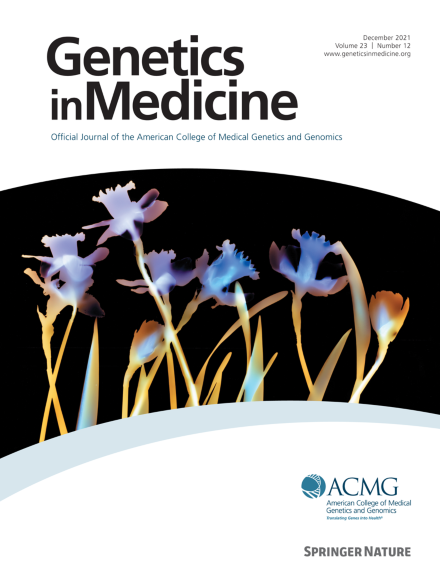额外的计算工具的校准扩展了ClinGen推荐选项的变体分类与PP3/BP4标准。
IF 6.6
1区 医学
Q1 GENETICS & HEREDITY
引用次数: 0
摘要
目的:我们之前开发了一种校准临床变异分类计算工具的方法,更新了变异影响预测因子可靠使用的建议,以提供强有力的证据。使用独特方法的新一代工具已经发布,这些方法必须独立校准用于临床应用。方法:使用我们基于局部后验概率的校准和我们建立的ClinVar致病和良性变异数据集,我们确定了三个新工具(AlphaMissense, ESM1b, VARITY)提供的证据强度和符合每个证据强度的校准分数。结果:所有三种工具都达到了变异致病性的强证据水平和良性的中等证据水平,尽管有时只有少数变异。与先前推荐的工具相比,这些工具在证据强度和假阳性预测的权衡方面最多只能得到适度的改善。结论:在校准的阈值下,三个新的计算预测因子提供了变异致病性的证据,其强度与先前推荐的四个预测因子相似(并且与某些变异的功能分析相当)。这种校准拓宽了应用于临床变异分类的计算工具的范围。他们的新方法为该领域的未来发展提供了希望。本文章由计算机程序翻译,如有差异,请以英文原文为准。
Calibration of additional computational tools expands ClinGen recommendation options for variant classification with PP3/BP4 criteria
Purpose
We previously developed an approach to calibrate computational tools for clinical variant classification, updating recommendations for the reliable use of variant impact predictors to provide evidence strength up to Strong. A new generation of tools using distinctive approaches has since been released, and these methods must be independently calibrated for clinical application.
Methods
Using our local posterior probability-based calibration and our established data set of ClinVar pathogenic and benign variants, we determined the strength of evidence provided by 3 new tools (AlphaMissense, ESM1b, and VARITY) and calibrated scores meeting each evidence strength.
Results
All 3 tools reached the Strong level of evidence for variant pathogenicity and Moderate for benignity, although sometimes for few variants. Compared with previously recommended tools, these yielded at best only modest improvements in the trade-offs between evidence strength and false-positive predictions.
Conclusion
At calibrated thresholds, 3 new computational predictors provided evidence for variant pathogenicity at similar strength to the 4 previously recommended predictors (and comparable with functional assays for some variants). This calibration broadens the scope of computational tools for application in clinical variant classification. Their new approaches offer promise for future advancement of the field.
求助全文
通过发布文献求助,成功后即可免费获取论文全文。
去求助
来源期刊

Genetics in Medicine
医学-遗传学
CiteScore
15.20
自引率
6.80%
发文量
857
审稿时长
1.3 weeks
期刊介绍:
Genetics in Medicine (GIM) is the official journal of the American College of Medical Genetics and Genomics. The journal''s mission is to enhance the knowledge, understanding, and practice of medical genetics and genomics through publications in clinical and laboratory genetics and genomics, including ethical, legal, and social issues as well as public health.
GIM encourages research that combats racism, includes diverse populations and is written by authors from diverse and underrepresented backgrounds.
 求助内容:
求助内容: 应助结果提醒方式:
应助结果提醒方式:


